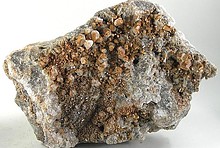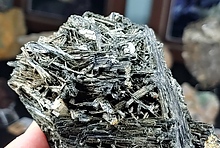Home PageAbout MindatThe Mindat ManualHistory of MindatCopyright StatusWho We AreContact UsAdvertise on Mindat
Donate to MindatCorporate SponsorshipSponsor a PageSponsored PagesMindat AdvertisersAdvertise on Mindat
Learning CenterWhat is a mineral?The most common minerals on earthInformation for EducatorsMindat ArticlesThe ElementsThe Rock H. Currier Digital LibraryGeologic Time
Minerals by PropertiesMinerals by ChemistryAdvanced Locality SearchRandom MineralRandom LocalitySearch by minIDLocalities Near MeSearch ArticlesSearch GlossaryMore Search Options
The Mindat ManualAdd a New PhotoRate PhotosLocality Edit ReportCoordinate Completion ReportAdd Glossary Item
Mining CompaniesStatisticsUsersMineral MuseumsClubs & OrganizationsMineral Shows & EventsThe Mindat DirectoryDevice SettingsThe Mineral Quiz
Photo SearchPhoto GalleriesSearch by ColorNew Photos TodayNew Photos YesterdayMembers' Photo GalleriesPast Photo of the Day GalleryPhotography
╳Discussions
💬 Home🔎 Search📅 LatestGroups
EducationOpen discussion area.Fakes & FraudsOpen discussion area.Field CollectingOpen discussion area.FossilsOpen discussion area.Gems and GemologyOpen discussion area.GeneralOpen discussion area.How to ContributeOpen discussion area.Identity HelpOpen discussion area.Improving Mindat.orgOpen discussion area.LocalitiesOpen discussion area.Lost and Stolen SpecimensOpen discussion area.MarketplaceOpen discussion area.MeteoritesOpen discussion area.Mindat ProductsOpen discussion area.Mineral ExchangesOpen discussion area.Mineral PhotographyOpen discussion area.Mineral ShowsOpen discussion area.Mineralogical ClassificationOpen discussion area.Mineralogy CourseOpen discussion area.MineralsOpen discussion area.Minerals and MuseumsOpen discussion area.PhotosOpen discussion area.Techniques for CollectorsOpen discussion area.The Rock H. Currier Digital LibraryOpen discussion area.UV MineralsOpen discussion area.Recent Images in Discussions
GeneralLooking for list of minerals and color temperatures
2nd Jan 2018 17:18 UTCPeter K. Szarka
Minerals of interest are:
Zeolites
Azurites
Malachites
Calcites
Fluorites
Smithsonites, Hemimorphites
Wulfenites, Mimetites
Metallic Oxides and Sulphides
Does anyone know if a comprehensive list can be found somewhere? Especially helpful would be references to the lighting used to optimize specific locality pieces, e.g Rogerley fluorites,
2nd Jan 2018 18:10 UTCRonald J. Pellar Expert

2nd Jan 2018 19:35 UTCGeorg Graf
to illuminate mineral spezimens for photography, I use the light of an old slide-projector. It is very "white" and gives a very steady light intensity.
Kind regards, Georg
2nd Jan 2018 23:10 UTCSteve Hardinger 🌟 Expert

3rd Jan 2018 17:39 UTCLászló Horváth Manager
Cameras (at least the DSLRs) can be set to a wide range of color temperatures. You can take a trial shots to see how your existing light source works with the color temperature setting of your camera and a particular mineral specimen and adjust it until you are happy with the results. And, the results are instant.
Back in the days of film with essentially daylight and tungsten balanced films available, it was a lot more complicated and the processing would take days or weeks (Kodakchrome, Agfachrome) before you would see the results.
3rd Jan 2018 18:13 UTCRonald J. Pellar Expert
If you are trying to get an exact appearance match, it can be a achieved with a lot of effort and care to match the monitor color temperature to the color temperature of the light source illuminating the specimen, as well as very neutral backgrounds, eye adaptation, etc. Only in very critical publishing requirements and at high cost will this be done.
The field of color perception and reproduction is very complicated and for most of us that just want good pictures, we must decide for ourselves what is "good enough". In most cases a few simple steps will yield "good enough" results. These steps are:
1) Use a broad spectrum light source, e.g., tungsten, tungsten-halogen, electronic flash, daylight, etc.
2) Use a spectrally flat gray card to set camera white balance.
3) Set camera output to Camera RAW or TIFF or, if the camera allows it, DNG. NO JPEG, i.e., no lossy compression!!!
4) Set camera bit depth to 12 or 14 bits to retain dynamic range.
Some cameras allow for fine tuning color temperature or white balance, but it easy to lose your way with this adjustment and is best left to the experts. A good spectrally neutral gray card can give very good results. A google search on camera gray cards will give many results to choose from at very reasonable prices.
7th Jan 2018 03:24 UTCPeter K. Szarka
My question should have been, what temp LED lights are used in a display cabinet for the groups of minerals mentioned. I'm trying to determine my needs for cabinet lighting based on the common standard of cool (5K), neutral (4K) and warm lighting (3K).

7th Jan 2018 05:36 UTCDoug Daniels
Thanks for the clarification. Unfortunately, with LEDs it's likely still not a simple matter. White LEDs, as I understand them, are made using red, green, and blue LEDs, in various proportions to create the different "colors" (more blue = cooler, more red = warmer). Each color LED has a specific wavelength, not a range. They are nowhere near the more full spectrum lights such as incandescent, etc. You may have to just get one of each of the three you mention, and see how they work with your particular specimens. You may find you need some of each type bulb, maybe with certain parts of your case lit with one type bulb, another part with another bulb, and so on, with each specimen placed under the "best" bulb. Or get really complicated and have all three lumped together to mimic a single bulb (probably not a good idea). Granted, I haven't started fooling with the LED bulbs yet, mainly because of the design - the light is emitted from the top half of the bulb, but apparently you get little shining downwards (thinking of typical table lamps).
7th Jan 2018 07:59 UTCJolyon Ralph Founder
No actually they're not made this way at all. the 'white' from an LED computer screen is generated this way, but not with 'white' LEDs in lighting.
Those are made by wrapping a UV LED in a highly fluorescent coating so that the UV from the LED makes the coating fluoresce in a broad white light.

7th Jan 2018 08:23 UTCAlfredo Petrov Manager
7th Jan 2018 08:44 UTCJolyon Ralph Founder
https://en.wikipedia.org/wiki/Color_rendering_index
7th Jan 2018 08:47 UTCJolyon Ralph Founder

7th Jan 2018 09:30 UTCAlfredo Petrov Manager
7th Jan 2018 09:53 UTCJolyon Ralph Founder
7th Jan 2018 10:12 UTCAlysson Rowan Expert
-------------------------------------------------------
> This is why a spectrometer is really what's needed
> :)
OR, you could just use a decent (dichroic) halogen spotlamp and play around with colour filters.
7th Jan 2018 10:54 UTCJolyon Ralph Founder
> OR, you could just use a decent (dichroic) halogen spotlamp and play around with colour filters.
That's not much help for cabinet lighting which was the original request.
7th Jan 2018 18:14 UTCRonald J. Pellar Expert
The most common and cheapest white LED's are fluorescent phosphors on top of blue LEDs. The newer, more expensive, LEDs with highter CRIs are using the phosphors on UV LEDs. They both have deficiencies in the green part of spectrum, but the UV LEDs are better in the green but may be worse in the blue. There are white LEDs that are composed of separate Red, Green, and Blue LEDs and usually have adjustable color temperatures. These are a bit more expensive but are somewhat better spectrally than the phosphor using LEDs, depending upon how broad the emission lines are for the RGB LEDs.
LEDs will get better in the future with either broader line emission for RGB LEDs or better phosphors and shorter wave UV LEDs.
As I recall, there was a very extensive discussion on light sources in the "Mineral Photography" thread a while back that had a lot more information than has been discussed here.
7th Jan 2018 20:46 UTCKevin Conroy Manager
8th Jan 2018 01:32 UTCPeter K. Szarka
@Ronald - speaking about the grey card makes me think the background for the cabinets should be grey, rather than black or white. Is there an argument to be made for this?
8th Jan 2018 18:53 UTCRonald J. Pellar Expert
in particular, dioptase, is very sensitive to deficiencies in the green part of the spectrum of the lighting used. Color Temperature is a relative measure of the amount of blue compared to red and is useless for the green sensitive dioptase. The best light for dioptase is tungsten-halogen lighting as it has a complete spectrum.
The choice of lighting is the same for displaying minerals as it is for photographing minerals and trying to get pleasing results. That is why I referred to discussions in the "Mineral Photograpy" forum for more detailed discussions. Although photography of minerals is further affected by considerations of camera metamerism, monitor considerations, etc., but the principles of lighting are the same.
8th Jan 2018 23:56 UTCPeter K. Szarka
Your explanation is highly appreciated.
Initially I decided use a black background but then I saw a few cabinets last Feb. with grey that looked nice. I think your reasoning helps solidify the choice for black. And I see I have a few challenges ahead. I'll look through the photo thread for more of the info. Thank you.
And thank you to everyone for their suggestions. The 4K avenue looks promising.




Mindat.org is an outreach project of the Hudson Institute of Mineralogy, a 501(c)(3) not-for-profit organization.
Copyright © mindat.org and the Hudson Institute of Mineralogy 1993-2024, except where stated. Most political location boundaries are © OpenStreetMap contributors. Mindat.org relies on the contributions of thousands of members and supporters. Founded in 2000 by Jolyon Ralph.
Privacy Policy - Terms & Conditions - Contact Us / DMCA issues - Report a bug/vulnerability Current server date and time: April 16, 2024 09:27:32
Copyright © mindat.org and the Hudson Institute of Mineralogy 1993-2024, except where stated. Most political location boundaries are © OpenStreetMap contributors. Mindat.org relies on the contributions of thousands of members and supporters. Founded in 2000 by Jolyon Ralph.
Privacy Policy - Terms & Conditions - Contact Us / DMCA issues - Report a bug/vulnerability Current server date and time: April 16, 2024 09:27:32











